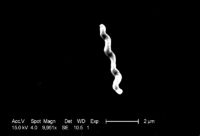Also known as: C. jejuni — C. fetus subsp jejuni — Vibrio jejuni
| Campylobacter jejuni | |
|---|---|
| Phylum | Proteobacteria |
| Class | Epsilon Proteobacteria |
| Order | Campylobacterales |
| Family | Campylobacteraceae |
| Genus | Campylobacter |
| Species | C.jejuni |
Introduction
Campylobacter jejuni belongs to the genus Campylobacter. C.jejuni is an important enteropathogen of man and a number of animal species. Although C. jejuni rarely causes fatal disease in animals, it is the leading cause of foodborne diseases in humans. It is the largest cause of food-poisoning in the UK and is therefore a public health issue causing diarrhoea and cramps.
It also causes late abortion and still births in sheep and goats, and may also cause mastitis in cattle. It is widespread on farms and is hyperendemic. It can be carried as commensals in the intestines of cattle, sheep, goats, dogs, cats, rabbits, wild birds and especially chickens. Farm animals are regularly exposed via the faecal-oral route. Maternal antibody protects the animal while the active immunity develops.
Animals with little exposure are very susceptible, e.g. humans and pets. Humans can become infected by faecal contaminated poultry skin, meat, milk and water sources. It can also be spread by humans via poor hygiene and during food processing. Most chicken carcasses are contaminated, leading to food poisoning and enterocolitis in people from uncooked meat. If frozen chicken is inadequately thawed, bacteria may remain viable in the abdominal cavity.
C. jejuni causes enteritis and diarrhoea in susceptible dogs and causes abortion in ewes. It usually causes asymptomatic infections in chickens and turkeys, but occasional outbreaks of avian hepatitis occur. It is implicated in [[Calf Diarrhoea, Undifferentiated Neonatal|undifferentiated neonatal calf diarrhoea]], a mixed viral enteritis in calves.
Pathogenesis
The pathogenesis of C.jejuni involves the colonisation, attachment and invasion of colonic enterocytes and toxin production.
It causes colitis, characterised by:
- Necrosis of absorptive epithelial cells
- Erosion of the mucosa
- Crypt abscesses
- Infiltration of inflammatory cells into the mucosa and the presence of primarily neutrophils.
The bacteria's functional flagella are important as virulence factors. Non-flagellate Campylobacter do not colonise in vivo, and are less invasive.
| Campylobacter jejuni Learning Resources | |
|---|---|
 Search for recent publications via CAB Abstract (CABI log in required) |
Campylobacter jejuni in the UK |
 Full text articles available from CAB Abstract (CABI log in required) |
Campylobacter jejuni - a monographic study (review). Corcionivoschi, N.; Drinceanu, D.; Ştef, L.; Julean, C.; Universitatea de Ştiinţe Agricole şi Medicină Veterinară a Banatului Timişoara, Timişoara, Romania, Lucrări Ştiinţifice - Zootehnie şi Biotehnologii, Universitatea de Ştiinţe Agricole şi Medicină Veterinară a Banatului Timişoara, 2009, 42, 1, pp 26-34, 48 ref. - Full Text Article |
| This article has been peer reviewed but is awaiting expert review. If you would like to help with this, please see more information about expert reviewing. |
